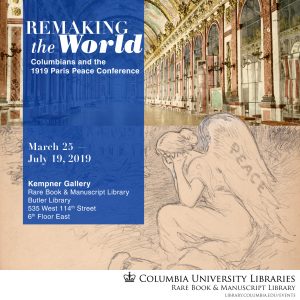If you’re enjoying PBS’ Women, War and Peace series, stop in to the RBML for our current exhibit, Remaking the World. The exhibit explores Columbia University’s connections to the 1919 Peace Conference. To be specific, the exhibit explores the role of men deemed significant to The Paris Peace Conference, also known as the Versailles Peace Conference.
Materials on display include selections from the papers of James T. Shotwell, historian of the American delegation and author of the day-to-day account At the Paris Peace Conference; the Carnegie Endowment for International Peace, founded by Andrew Carnegie in 1910, with Columbia President Nicholas Murray Butler serving on the board of directors from 1910 until 1945; Charles Richard Crane, appointed to the American delegation by Woodrow Wilson and co-author of the King-Crane Commission on the post-war future of the Middle East; and Wellington Koo, Columbia Class of 1908 and PhD (1912), a member of the Chinese delegation to the Peace Conference, China’s first delegate to the League of Nations, and one of the founding delegates to the United Nations.
Consider our exhibit a supplement or a historical “master narrative” against which to watch the PBS series. After all, with something called “suffrage” happening at the same time, that the men who attended the Paris Peace Conference thought they were going to remake the world without half the population emphasizes, as the series notes, “Women weren’t written out of history — they were never written in.” [trailer]
